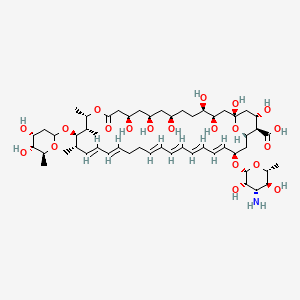| MeSH term | MeSH ID | Detail |
|---|---|---|
| Peritonitis | D010538 | 38 associated lipids |
| Cystic Fibrosis | D003550 | 65 associated lipids |
| Hypertension | D006973 | 115 associated lipids |
| Hemolysis | D006461 | 131 associated lipids |
| Body Weight | D001835 | 333 associated lipids |
Nystatin A3
Nystatin A3 is a lipid of Polyketides (PK) class. Nystatin a3 is associated with abnormalities such as Mycoses, Candidiasis of the genitals and Gigantism. The involved functions are known as Drug Interactions, Process, Synthesis, Fermentation and Anabolism. Nystatin a3 often locates in Cell membrane, Membrane, Protoplasm, Entire oral cavity and integral to membrane. The associated genes with Nystatin A3 are Gene Clusters. The related lipids are Sterols, 1,2-oleoylphosphatidylcholine, Membrane Lipids, DOPE and N-caproylsphingosine.
Cross Reference
Introduction
To understand associated biological information of Nystatin A3, we collected biological information of abnormalities, associated pathways, cellular/molecular locations, biological functions, related genes/proteins, lipids and common seen animal/experimental models with organized paragraphs from literatures.
What diseases are associated with Nystatin A3?
Nystatin A3 is suspected in Mycoses, Candidiasis of the genitals, Gigantism and other diseases in descending order of the highest number of associated sentences.
Related references are mostly published in these journals:
| Disease | Cross reference | Weighted score | Related literature |
|---|
Possible diseases from mapped MeSH terms on references
We collected disease MeSH terms mapped to the references associated with Nystatin A3
PubChem Associated disorders and diseases
What pathways are associated with Nystatin A3
There are no associated biomedical information in the current reference collection.
PubChem Biomolecular Interactions and Pathways
Link to PubChem Biomolecular Interactions and PathwaysWhat cellular locations are associated with Nystatin A3?
Visualization in cellular structure
Associated locations are in red color. Not associated locations are in black.
Related references are published most in these journals:
| Location | Cross reference | Weighted score | Related literatures |
|---|
What functions are associated with Nystatin A3?
Related references are published most in these journals:
| Function | Cross reference | Weighted score | Related literatures |
|---|
What lipids are associated with Nystatin A3?
Related references are published most in these journals:
| Lipid concept | Cross reference | Weighted score | Related literatures |
|---|
What genes are associated with Nystatin A3?
Related references are published most in these journals:
| Gene | Cross reference | Weighted score | Related literatures |
|---|
What common seen animal models are associated with Nystatin A3?
There are no associated biomedical information in the current reference collection.
NCBI Entrez Crosslinks
All references with Nystatin A3
Download all related citations| Authors | Title | Published | Journal | PubMed Link |
|---|---|---|---|---|
| Kinoshita H et al. | Cryptic antifungal compounds active by synergism with polyene antibiotics. | 2016 | J. Biosci. Bioeng. | pmid:26323525 |
| Ellepola AN et al. | Impact of brief exposure to antifungal agents on the post-antifungal effect and hemolysin activity of oral Candida albicans. | 2015 Jul-Aug | J Appl Oral Sci | pmid:26398514 |
| Okechukwu DC et al. | Evaluation of the anti-candidal activity of methanolic leaf extract of cleistopholis patens (fam. Annonaceae) on candida species isolated from stage II HIV patients. | 2015 | Afr Health Sci | pmid:26957966 |
| Mobasheri M et al. | Solubilization Behavior of Polyene Antibiotics in Nanomicellar System: Insights from Molecular Dynamics Simulation of the Amphotericin B and Nystatin Interactions with Polysorbate 80. | 2015 | Molecules | pmid:26712721 |
| Franiczek R et al. | β-Aescin at subinhibitory concentration (sub-MIC) enhances susceptibility of Candida glabrata clinical isolates to nystatin. | 2015 | Med. Mycol. | pmid:26092104 |
| Bodin MB et al. | Topical Nystatin for the Prevention of Catheter-Associated Candidiasis in ELBW Infants. | 2015 | Adv Neonatal Care | pmid:25938952 |
| Boros-Majewska J et al. | A novel in vitro assay for assessing efficacy and toxicity of antifungals using human leukaemic cells infected with Candida albicans. | 2015 | J. Appl. Microbiol. | pmid:25845720 |
| Trindade LA et al. | Inhibition of adherence of C. albicans to dental implants and cover screws by Cymbopogon nardus essential oil and citronellal. | 2015 | Clin Oral Investig | pmid:25804885 |
| Farrag HA et al. | Microbial colonization of irradiated pathogenic yeast to catheter surfaces: Relationship between adherence, cell surface hydrophobicity, biofilm formation and antifungal susceptibility. A scanning electron microscope analysis. | 2015 | Int. J. Radiat. Biol. | pmid:25758055 |
| Kandile NG and Zaky HT | New pyrano[2,3-c]pyridazine derivatives with antimicrobial activity synthesized using piperidine as the organocatalyst. | 2015 | J Enzyme Inhib Med Chem | pmid:24666292 |
